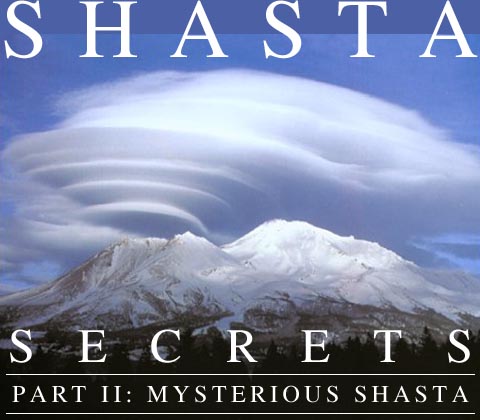
Editorial
|
Fragments
|
Shasta II
|
Sea Serpents II
|
Atlantis II
Register
for our new Hall of Records Newsletter!
Questions? Comments? Suggestions? Advertising? Press Releases?
Contact us!
Shasta Secrets Part I: Visiting Mt. Shasta
Mysterious California
|
Mysterious Shasta
|
Shasta Today
|
Links
|
Books
|
Audio
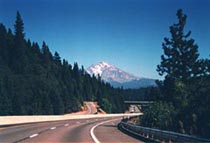
 ysterious Shasta beckons the world-weary traveler, eager to escape from the world of the mundane into the world of the divine.
Even the stark, rolling beauty of the northern California highway, flirting with the foothills of the
Sierra Nevada,
sharply gives way to the sublime majesty of mighty Shasta's peak. Upon approaching the scenic beauty of the great mountain and its
numerous
secondary features,
one feels somehow transported to another land, to a magical, former time when life was simpler, and grander.
ysterious Shasta beckons the world-weary traveler, eager to escape from the world of the mundane into the world of the divine.
Even the stark, rolling beauty of the northern California highway, flirting with the foothills of the
Sierra Nevada,
sharply gives way to the sublime majesty of mighty Shasta's peak. Upon approaching the scenic beauty of the great mountain and its
numerous
secondary features,
one feels somehow transported to another land, to a magical, former time when life was simpler, and grander.
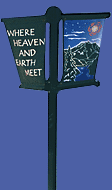
My first experience with Shasta was as a side trip while visiting relatives in northern California one summer. I was expecting to
experience the typical day trip: a good day's hike, some nice scenery, a good meal at a local restaurant, some nice souvenirs
to take home, and perhaps some interesting experiences to talk about around the dinner table. However, what I got was a
wide array of sights and experiences
that impressed me perhaps more than any other single travel destination I had experienced, either before or since.
After some window
shopping
in cozy downtown
Mount Shasta city,
a luxurious hike on Shasta's
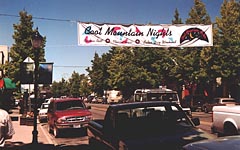 Bunny Flat Trail,
and a visit to the
Sisson Museum,
my traveling companions and I settled down for a bite to eat at the
Black Bear Diner,
a great little diner southeast of the city center. Chomping down on a massive bacon cheeseburger called the "Papa Bear Burger"
— the best I've ever had anywhere, by the way — I noticed that they had a small, custom-made newspaper called the
Black Bear Gazette, which also serves as their menu (nice touch). On the cover of one of the gazette/menus (there were several
versions), was an intriguing story called, "Shasta's 'Sphinx Rock' — Made by Man or Nature?".
The story related the tale of one Frank Bascom of
Dunsmuir
(another Shasta town just south and east of Mount Shasta city) and one of the discoveries he had made while hiking on the upper
slopes of Shasta, way back in 1937:
Bunny Flat Trail,
and a visit to the
Sisson Museum,
my traveling companions and I settled down for a bite to eat at the
Black Bear Diner,
a great little diner southeast of the city center. Chomping down on a massive bacon cheeseburger called the "Papa Bear Burger"
— the best I've ever had anywhere, by the way — I noticed that they had a small, custom-made newspaper called the
Black Bear Gazette, which also serves as their menu (nice touch). On the cover of one of the gazette/menus (there were several
versions), was an intriguing story called, "Shasta's 'Sphinx Rock' — Made by Man or Nature?".
The story related the tale of one Frank Bascom of
Dunsmuir
(another Shasta town just south and east of Mount Shasta city) and one of the discoveries he had made while hiking on the upper
slopes of Shasta, way back in 1937:
Bascom liked to hike on the upper slopes of Mt. Shasta, and he always took his camera. One day he was photographing the sulphur springs
near the top of the mountain and also other odd formations when he unknowingly snapped a picture of
Sphinx Rock.
The next day he was
developing his prints and in one of them he saw an awesome face on a huge boulder. He became very excited about it and went back up
the mountain the next day to hunt for the strange face.... Bascom finally located the boulder on the point of a ridge which faces
due south in Clear Creek Canyon ... one half mile northwesterly from Mud Creek.1

After experiencing the more conventional, "touristy" aspects of the Shasta area, this story about the "Sphinx Rock" brought back to
mind the mystique of the area that I had read about in books such as
Mysterious California
and Rosemary Ellen Guiley's
Atlas of the Mysterious in North America.
These sources told whispered tales and rumours of spectral beings that haunt Shasta's slopes, of dwarves and ape-men who skulk about
its lofty shoulders in broad daylight before many witnesses, only to disappear without a trace. As Guiley explains,
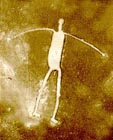
|
|
The "Blythe Giant", an ancient petroglyph similar to those found in
Nazca,
Peru. Image from
Survive 2012.
|
The Hopi believe that a race of lizard men have a city underneath the volcano, as well as beneath the city of Los Angeles. The mountain
also is said to be the home of the legendary Lemurians, who survived the catastrophic sinking of the lost continent of Lemuria in the
Pacific Ocean thousands of years ago. Many sightings of ape men and hooded phantoms have occurred.2
California is actually one of the wierdest places on Earth. From
the city
of
Blythe's
giant
petroglyphs,
ancient seagoing vessels found marooned in the
Yuma desert near the
Salton Sea,
rumours of
giant mummies
buried in various parts of the state and, of course, the ubiquitous
Bigfoot
sightings, Shasta's stories fit right in with the ancient and exotic travel millieu of the western
United States.3 No
Hollywood script
can hold a candle to some of the bizaare and
mysterious artifacts left behind by countless ancient cultures that have left their imprints on the California landscape over the
last several thousand years. And perhaps the greatest of these imprints are those that have been left behind on mysterious Shasta.

Some mysterious places are born with legendary qualities, others have legendary qualities thrust upon them. Both are the case with
Mt. Shasta, which has been the subject of mystical speculation perhaps more than any other single mountain in history.

Shasta was first discovered in 1826 by a Hudson's Bay Company trapper by the name of Peter Skene Ogden, who named the lonely mountain
"Sastise" after a local tribe of the same name.4 Early in the 20th century, ethnologists found a variety
of Native American tribes living around the base of Mt. Shasta, and collected a number of tribal myths and legends as part of their
study. They found that these tribes were variously related to several major Native American cultures, and as a result they found that
Mt. Shasta was "an integral part of the mythology of the peoples of a large cultural sphere. There were legends of
Coyote
on Mt. Shasta, typical of cultures both in central California and northward. The personification of Wind, which was very common to the
Northwest Coast tribes, was also often a factor in legends surrounding the mountain."5
Native Americans, as with all ancient cultures, tended to define the world in terms of natural forces. As a result, the most prominent
natural forces, such as the wind, the rain, the sun, moon and stars, animals, plants, forests, hills, and mountains were all accorded a
reverence relative to their effect upon their lives. Thus Shasta, which was such a dominant figure on the skyline, and which occasionally
roared forth with powerful volcanic forces, became the center of their lives, and of their myths.
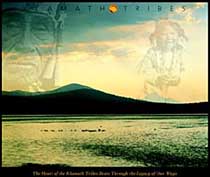
The official Klamath tribes tribal poster from the
Klamath Tribes website.
The Modoc are one of the three Klamath tribes that live
in the vicinity
of Shasta. Proceeds from purchases of this 18" x 24" poster go to The Klamath Tribes Basket Fund. See their
website.
for details.
|
Mt. Shasta was the unmistakeable physical and visual center of several tribes. It was customary for great peaks to be regarded by
Native American peoples as the starting point of their many boundaries. And, in spite of the differences among tribes in locations,
languages, and tribal affiliations, Shasta was recognized by each in its own way as something of such immense grandeur that its
existence could only be attributed to the Great Spirit, or Creator. The mountain, therefore, was also the tribes' spiritual center:
it was held to be the Great Spirit's wigwam. The smoke and steam seen as the summit was the smoke-hole of the Spirit's lodge, as well
as the entrance to the Earth. Native American legends connected the material and spiritual worlds and described the powerful natural
forces that people witnessed in their environment.6
One myth involved Coyote, the ubiquitous
trickster
character, and The Great Flood which,
as we have seen,
shows up frequently in the myths of many ancient peoples. According to one Native American Flood story, Coyote, "the shrewd trickster
and people's perpetual nemesis"7, was walking by the water one day, and an evil spirit in the lake caused
the water to rise up in order to cover him. Coyote shot the spirit with his bow, but the water kept coming, so he ran away, the water
following after him. Coyote ran onto higher ground, but the water continued to chase after him. Coyote then ran up to the top of Mt.
Shasta in order to escape the raging water, as that was the only dry place left. There he made a fire, where the other animals ran to
to escape the Flood. After the Flood, they then came down off of the mountain, and became the ancestors of all of the animals on Earth.
The
Modoc
tribal origin story also involves Shasta. The story goes, thousands of snows ago, there was a great storm over Mt. Shasta. The Great
Spirit, who lived within the mountain, sent his youngest daughter out to speak to the storm and tell it to stop blowing so hard, or
else the mountain might blow over. He also told her not to stick her head out the top of the mountain, or the wind could catch her
long, red hair, and blow her away. The girl, however, having never seen the sea, was overcome with curiosity and stuck her head out of
the top of the mountain to see it. As her father the Great Spirit had warned, her long, red hair caught the mighty wind, and she was
blown away. Fortunately a group of Grizzly bears found her and took her in. These Grizzly bears were not like modern Grizzlies,
however, they were more like humans, walking on two feet, and when the Great Spirit's daughter came of age, she married the oldest
Grizzly's son. Their children were then a combination of spirit and animal, having the nature of both; they were the first
Modocs.8

The modern myths possess many of the same characteristics the ancient Native American myths, in that they recognize the sacredness of
the mountain and its central importance to the history of the area. They are also no less fantastic than the tales of Coyote, the
Great Spirit's daughter, and the many other tales told by the area's native inhabitants.
One of Shasta's secrets is its many tales of ancient and unusual races that are believed to populate its interior. One race is the
Yaktavians, who are said to be the greatest bellmakers in the world. Through their use of sound and vibration, they are believed to have
hollowed out vast underground tunnel systems and cities. It is also believed by some that "great transparent bells, invisible to mortals,
are used to protect the secret mountainside entrances to their caverns."9 As part of this modern myth, it
is believed that the sound of the wind blowing against the lips of these transparent bells — which can only be seen from a few feet
away — creates a highly unpleasant tone that is just out of the range of hearing. This unpleasant tone is believed to subconsciously
repel both the curious and the ignorant in order to keep them from discovering these secret entrances.
Perhaps it was these bells, or the entrances that they guarded, that in the 1930s one Edgar Larkin of Mount Lowe Observatory in southern California claims to have observed while testing the observatory's more powerful telescopes. Larkin is reported to have seen "a
glimmering curved surface that was truly unusual."10 Upon later observations, he found what appeared to
him to be two or three oriental-looking, gold-tinted domes, and the corner of what appeared to be a marble building. After more observations Larkin claimed that the domes continued to emit light even after dark, proving that they were of artificial origin.
However, as Emilie Frank suggests in
Mt. Shasta: California's Mystic Mountain
the "gold-tinted domes" are most likely sulphur-encrusted, dome-shaped rocks that can be found on the slopes of
Shasta.11 Another probable candidate is
Castle Crags
just south of Mt. Shasta — which lay between southern California and Shasta — specifically the
Castle Dome,
a dome-shaped prominence on the crags. Over a long distance, and with distortions caused by lenses, focal length, and atmosphere,
these crags could easily be transformed by the imaginative mind to be mysterious domes far up on the slopes of Shasta.
Another race of beings believed to live within the mountain are a race of dwarves, or "little men". One account tells the tale of how one
"Mah-Atmah Amsumata", a.k.a. Norman Westfall, was picnicking with friends on the slopes of Shasta one day when they were approached by a
"tiny dwarf" (vertically challenged?) who offered to bring them some gold:
He then disappeared and soon returned with a sack of what appeared to be coal. The dwarf explained, however, that the sack contained
black diamonds and that within them lay a secret. Westfall relates that they suddenly realized that this was a dwarf of vast wisdom,
and strangely enough, other dwarfs appeared and explained that they were from the lost continent of Lemuria. The tiny men began to
sing, seeming to blend their voices in a chorus of beautiful cosmic sounds — all the while working with tiny anvils and
hammers.... Then, amazingly, there appeared another being, somewhat larger than the others. Lordlike in appearance, he introduced
himself as Pelleur, the Lord of Wisdom of Lemuria, the great dwarf who sits in the center of the four corners of the
earth.12

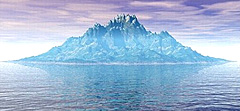 |
|
An artistic representation of one of the islands of Lemuria, or "Mu". Image from
Lemuria.net.
|
One of the most powerful and enduring legends regarding Mt. Shasta is its supposed
"Lemurian" heritage.
Lemuria was an ancient,
theoretical continent
or series of continents that were spread all across the
Pacific, thousands of years ago. Then, after a series of natural (some believe manmade) disasters, the large islands that made up the
bulk of Lemuria sank beneath the sea, forever silencing the ancient voices of this antediluvian people. The belief that Mt. Shasta is
the last outpost of this mysterious ancient race is probably the most widely held among those who study the history and lore of the
area. Michael Zanger explains in
Mt. Shasta: History Legend and Lore,
Lemurians, Atlanteans, and other lost races sequestered within Mt. Shasta are often-told stories. Supposedly, Lemuria was once a
great continent in the area now covered by the Pacific Ocean. The continent's eastern shore had once been part of the present states
of California, Oregon, and Washington, separated from the rest of North America by a large inland sea.... Lemuria is said to have
disappeared into the Pacific during a cataclysm that changed the geography of the entire globe. Some Lemurian people migrated east
when their continent began to sink and made their way to Mt. Shasta. Because of their very advanced knowledge of science, energy,
and cosmic powers, the Lemurians fashioned huge caverns within the mountain and were self-sustaining in every
respect.13
Probably the first known reference to "Lemuria" in reference to Shasta occurred in 1883. A young
Yreka
teenager by the name of Frederick Spencer Oliver, while working on marking the boundaries of his family's mining claim, suddenly found
himself writing uncontrollably on the notebook he had brought along for the task. He immediately ran home in terror and, when he finally
reached home, he sat down and allowed the strange force motivating his hand to write freely. These "automatic writing" spells continued
on and off for several years, where he would write out a few pages, and then the strange force would stop, leaving as abruptly as it had
come. By 1895 he had finished a complete book, which he titled
A Dweller on Two Planets,
which has since proved to be a major New Age text.
The story that emerged from Oliver's automatic writings was that he had been chosen as the amanuensis, or secretary, to an ancient,
disembodied Lemurian spirit named "Phylos".
Oliver claimed that Phylos, who lived during several previous incarnations on Atlantis, took him to mysterious temples and elaborate
dwelling places of a mystic brotherhood within Mt. Shasta. He wrote that the interior of the mountain contained a labyrinth of great
corridors with walls of polished jewels and floors carpeted with fur. The entrance to Mt. Shasta's inner sanctum was supposedly
by a clear pool near a branch of the McCloud River on the mountain's east side.14
In 1931, another writer by name of Spencer Lewis published another book linking Shasta with the mysterious lost continent of Lemuria,
publishing it under the nom de plume of Wishar Cerve. This book, enitled
Lemuria: The Lost Continent of the Pacific,
is supposedly based upon long-lost Asian manuscripts that describe Lemuria as having risen and fallen as long as 5 million years ago,
making it much, much older than Oliver's Phylos had described it.
Cerve recounted tales of strange-looking, robed persons emerging from the forests and coming into nearby towns surround Mt. Shasta to
trade gold nuggets for supplies: 'These odd looking persons were not only peculiar in their dress and different in attire from
any costume ever seen on the American Indian, and especially in the California Indian, but distinctive in features and complexion;
tall, graceful and agile, having the appearance of being quite old and yet exceedingly virile.' A protrusion in the center of their
very high foreheads was said to be a special organ enabling them to communicate by telepathy. When approached by townspeople, the
Lemurians would apparently vanish into thin air.15
In the same year (1931), another book specifically dealing with the lost continent of "Mu" (another name for Lemuria) was published.
This book, appropriately entitled
The Lost Continent of Mu,
was written by a Colonel in the British Army named James Churchward. Churchward, who was stationed in India, claimed to have befriended
a high priest in one of the local temples who taught him how to decipher the ancient stone tablets locked away in their vaults. And it
was from these ancient tablets that Churchward claims to have learned the history of an ancient, sunken continent called Mu:
Churchward tells of Mu, a strange country of 64 million inhabitants who had developed a superior civilization and was at the height
of her magnificence 50,000 or more years ago. Mu was an immense continent which covered half of what is now the Pacific Ocean, and
was thousands of miles long. The very southern tip contained what is now Easter Island (with its 555 carved statues), some of which
did not sink. Churchward tells of the dominant people of Mu, a white race. But besides this race, there were other races, people with
black, yellow, or brown skin. The ancient inhabitants of Mu were excellent navigators and sailors who took their ships all over the
world. They were also learned architects, building great temples and and palaces of stone, carving and setting up great monoliths
as monuments.16
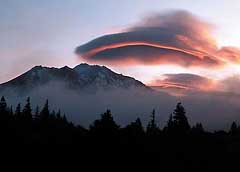
A lenticular cloud forming over Shasta. One modern myth has it that these unusual cloudforms are specifically formed by UFOs,
for the purpose of concealing their movements. Image ©
Jane English.
Click here
to purchase her latest calendar!
|
Yet another legend involving the Lemurians (there are dozens) contradicts the commonly accepted notion of Lemurians living within
the mountain. Instead, as one Dr. M. Doreal states in a newsletter put out by the Brotherhood of the White Temple in Sedalia, Colorado
entitled Mysteries of Mount Shasta, that it is
Atlanteans,
not Lemurians, who inhabit Mt. Shasta. Though the Lemurians had indeed created vast, underground pleasure palaces beneath the
mountain, they had lost their freedom in a great war with the Atlanteans, and remain imprisoned by the Atlanteans in their pleasure
palaces even today. "After their retreat, the Atlantean victors sealed the entrance and established an elaborate guard
system which prohibits the Lemurians to ever escape their bondage. The Atlanteans, Dr. Doreal states, still reside in their colony
beneath Mt. Shasta and commute every three months by strange cigar-shaped airships to that area in the South Pacific in order to
check the sealed entrance of the imprisoned Lemurians."17 It is these aircraft, some say, that
accounts for the occasional appearances of UFOs above Mt. Shasta.




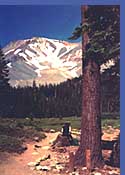 Shasta today has become more a popular resort town in northern California than a mystical hermitage for New Age spiritualists, though
the mystical side of Shasta remains a potent force in the town's cultural evolution. From the Harmonic Convergence of 1987 to the regular
visits of Tibetan monks and well-known spiritualists, Shasta's mystical heritage is consistently reaffirmed by the belief of
many worldwide that it is a major spiritual power center. Moreover, the regular sightings of unexplained lights over Shasta's glistening
peaks and the regular recurrence of mysterious lenticular clouds keeps one wondering whether some of the whispered tales of Shasta's
secrets are true. For the seeker of spiritual enlightenment, or the adventurous soul looking for new frontiers to conquer, Shasta's
secrets still remain unsolved, and the heart of the lonely mountain still remains unconquered.
Shasta today has become more a popular resort town in northern California than a mystical hermitage for New Age spiritualists, though
the mystical side of Shasta remains a potent force in the town's cultural evolution. From the Harmonic Convergence of 1987 to the regular
visits of Tibetan monks and well-known spiritualists, Shasta's mystical heritage is consistently reaffirmed by the belief of
many worldwide that it is a major spiritual power center. Moreover, the regular sightings of unexplained lights over Shasta's glistening
peaks and the regular recurrence of mysterious lenticular clouds keeps one wondering whether some of the whispered tales of Shasta's
secrets are true. For the seeker of spiritual enlightenment, or the adventurous soul looking for new frontiers to conquer, Shasta's
secrets still remain unsolved, and the heart of the lonely mountain still remains unconquered.



For more information, contact the Mt. Shasta Chamber of Commerce, 300 Pine Street, Mt. Shasta, CA 96067 USA; toll free: 1-800-397-1519; phone: 530-926-4865; fax: 530-926-0976; e-mail:
visit@mtshastachamber.com, or
o-shasta@inreach.com;
website:
http://www.mtshastachamber.com
or consult the following links:
Shasta Secrets Part I: Visiting Mt. Shasta
Mysterious California
|
Mysterious Shasta
|
Shasta Today
|
Links
|
Books
|
Audio
Editorial
|
Fragments
|
Shasta II
|
Sea Serpents II
|
Atlantis II
Register
for our new Hall of Records Newsletter!
Questions? Comments? Suggestions? Advertising? Press Releases?
Contact us!

1
Emilie A. Frank,
Mt. Shasta: California's Mystic Mountain
(Hilt, California: Photografix Publishing, 1998), 73.
2
Rosemary Ellen Guiley,
Atlas of the Mysterious in North America
(New York: Facts On File, 1995), 93.
3
David Hatcher Childress,
Lost Cities of North & Central America
(Stelle, IL: Adventures Unlimited Press, 1992), 507-525.
4
Michael Zanger,
Mt. Shasta: History, Legends & Lore
(Berkeley, CA: Celestial Arts Publishing, 1992), 20-21.
5
Zanger,
Mt. Shasta: History, Legends & Lore, 89.
6
Ibid, 91.
7
Ibid, 92.
8
Ibid, 92-93.
9
Ibid, 99.
10
Frank,
Mt. Shasta: California's Mystic Mountain, 73.
11
Ibid, 195.
12
Ibid, 86-87.
13
Zanger,
Mt. Shasta: History, Legends & Lore, 99.
14
Ibid, 98.
15
Ibid, 99-100.
16
Frank,
Mt. Shasta: California's Mystic Mountain, 182.
17
Ibid, 47.

 The Sierra Nevada Mountains
The Sierra Nevada Mountains
 Map of Shasta
Map of Shasta
 Mount Shasta Chamber of Commerce
Mount Shasta Chamber of Commerce
 Bunny Flat Trail
Bunny Flat Trail
 Sisson Museum
Sisson Museum
 Black Bear Diner
Black Bear Diner
 Dunsmuir
Dunsmuir

 About.com: The Nazca Lines
About.com: The Nazca Lines
 Survive 2012: The Blythe Giant & Other Petroglyphs
Survive 2012: The Blythe Giant & Other Petroglyphs
 City of Blythe, California
City of Blythe, California
 Blythe Chamber of Commerce
Blythe Chamber of Commerce
 The Yuma desert
The Yuma desert
 The Salton Sea
The Salton Sea
 Giant Mummies
Giant Mummies
 Bigfoot
Bigfoot
 Hollywood script
Hollywood script

 The Trickster/Coyote Myth
The Trickster/Coyote Myth
 Klamath Tribes website
Klamath Tribes website
 Klamath Tribes map
Klamath Tribes map
 Klamath Tribes poster
Klamath Tribes poster
 The Modoc Tribe
The Modoc Tribe
 Jane English, Mt. Shasta Photographer
Jane English, Mt. Shasta Photographer
 Castle Dome
Castle Dome
 Castle Crags
Castle Crags
 Lemuria.net: Lemuria
Lemuria.net: Lemuria
 Hawaiian.net: Lemuria
Hawaiian.net: Lemuria
 Millennium Matters 2000: Lemuria
Millennium Matters 2000: Lemuria
 Yreka Chamber of Commerce
Yreka Chamber of Commerce
 Lemuria Resort
Lemuria Resort

 Shasta Secrets Part I: Visiting Mt. Shasta
Shasta Secrets Part I: Visiting Mt. Shasta
- Shasta Sporting
- Shasta Shopping
- Shasta Snacking
- Shasta Sleeping
- Shasta Links
- Shasta Books
 Mt. Shasta Chamber of Commerce
Mt. Shasta Chamber of Commerce
 Mt. Shasta Chamber of Commerce: Calendar of Events
Mt. Shasta Chamber of Commerce: Calendar of Events
 Mt. Shasta Chamber of Commerce: How to Get Here
Mt. Shasta Chamber of Commerce: How to Get Here
 Mt. Shasta City Online
Mt. Shasta City Online
 ShastaHome.com
ShastaHome.com
 ShastaHome.com: Visitor's Guide
ShastaHome.com: Visitor's Guide
 Mount Shasta Region Travel Center
Mount Shasta Region Travel Center
 Northern California Travel and Tourism Information Network
Northern California Travel and Tourism Information Network
 Siskiyou County Visitor's Bureau
Siskiyou County Visitor's Bureau
 Mt. Shasta Live
Mt. Shasta Live
 Shasta County Visitor's Bureau
Shasta County Visitor's Bureau
 California Environmental Resources Evaluation System: Siskiyou County
California Environmental Resources Evaluation System: Siskiyou County
 United States Geological Survey: Mount Shasta
United States Geological Survey: Mount Shasta
 Mount Shasta Collection
Mount Shasta Collection
 College of the Siskiyous
College of the Siskiyous
 Shasta Vacations
Shasta Vacations
 Dunsmuir Chamber of Commerce
Dunsmuir Chamber of Commerce
 McCloud Chamber of Commerce
McCloud Chamber of Commerce
 Weed Chamber of Commerce
Weed Chamber of Commerce
 Yreka Chamber of Commerce
Yreka Chamber of Commerce
 Redding, California Home Page
Redding, California Home Page
Editorial
|
Fragments
|
Shasta II
|
Sea Serpents II
|
Atlantis II
Register
for our new Hall of Records Newsletter!
Questions? Comments? Suggestions? Advertising? Press Releases?
Contact us!


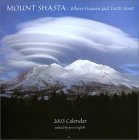 Mt. Shasta 2003 Calendar: Where Heaven and Earth Meet
Mt. Shasta 2003 Calendar: Where Heaven and Earth Meet
Jane English
Rating:




Towering 14,162 feet above far northern California, Mount Shasta is a landmark comparable to Japan's Mount Fujiyama. Home to California's largest glacier, it is one of the volcanoes of the Cascade Range, part of the Pacific "Ring of Fire."
The photographs and writings in this calendar give many diverse perspectives on this magnificent mountain.
Renowned photographer English and journalist Coyle created this wonderful pictorial tribute to Mount Shasta, supported by a strong cast of locals and visitors, and their personal experiences with this sacred mountain. (Review by Amazon.com)
Click
here
to buy this calendar.
 Mt. Shasta California's Mystic Mountain
Mt. Shasta California's Mystic Mountain
Emilie A. Frank
Rating:




This 27-chapter book with 208 pages, loaded with photographs, includes interviews with unusual and/or psychic persons who have had transcendental experiences on Mt. Shasta. Another claimed to have met an "Ascended Master" named Saint Germain beside a stream on the mountain, was spiritually taught and told to form The Saint Germain Foundation, which also has worldwide followers. Also, included are exclusive interviews; strange occult "happenings" on the mountain; descriptions of the mysterious circles, mounds, domes and pyramids found on the slopes of Mt. Shasta; UFO activity in the immediate realm of Mt. Shasta (which includes the alleged abduction of a Happy Camp woman); complete account of the 1987 Harmonic Convergence on the slopes of Mt. Shasta -- which led to an occult happening bringing even more national media attention; and an account of Elizabeth Clare Prophet's visit and her channeled messages from Lemurian beings and "Masters" within Mt. Shasta.
(Review by Amazon.com)
Click
here
to buy this book.
 Mt. Shasta: History, Legend & Lore
Mt. Shasta: History, Legend & Lore
Michael Zanger
Rating:




Virtually unknown until the early 1800s, Northern California's solitary Mount Shasta is widely acknowledged as a spot of great beauty and power. This fascinating book by Shasta guide and scholar Michael Zanger draws on a wide range of traditions and sources to present the most complete history of the mountain ever written. Native American legends, tales from early explorers and Gold Rush Forty-niners, and accounts of geological discoveries are accompanied by hundreds of period photos, engravings, and documents.
(Review by Amazon.com)
Click
here
to buy this book.
 Lost Cities of North & Central America (The Lost City Series)
Lost Cities of North & Central America (The Lost City Series)
David Hatcher Childress
Rating:




From the jungles of Central America to the deserts of the southwest ... down the back roads from coast to coast, maverick archaeologist
and adventurer David Hatcher Childress takes the reader deep into unknown America. In this incredible book: search for lost Mayan cities
and books of gold; discover and ancient canal system in Arizona; climb gigantic pyramids in the Midwest; explore megalithic monuments
in New England; and join the astonishing quest for the lost cities throughout North America. From the war-torn jungles of Guatemala,
Nicaragua and Honduras to the deserts, mountains and fields of Mexico, Canada and the U.S.A., Childress takes the reader in search of
sunken ruins, Viking forts, strange tunnel systems, living dinosaurs, early Chinese explorers, and fantastic gold treasure. Lost Cities
of North & Central America is packed with both early and current maps, photos, and illustrations. Join David on an unforgettable tale of
life on the road in search of the solutions to the ancient mysteries of the past!
(From the back cover)
Click
here
to buy this book.
 A Bag Of Bones: Legends of the Wintu Indians of Northern California
A Bag Of Bones: Legends of the Wintu Indians of Northern California
Marcelle Masson
Rating:



A wonderful, warm and exciting collection of Native American legends and stories from Northern California's Wintu Indians.
Told by the descendant of the last chief of this tribe, this collection will transport you to a different time and culture.
Marvelous stories, marvelously told. (Review by Amazon.com)
Click
here
to buy this book.
 A Coyote Reader
A Coyote Reader
William Bright
Wily, raunchy, and heroic. A trickster, lecher, and supreme survivor. Such is the magical Coyote, that mythic Native American
figure whose various roles are recounted here in a wonderful selection of poetry and stories. Anthropological linguist William
Bright brings together diverse portraits of Coyote from American Indian texts and modern American writing. Because Native American
myths have been recited and transmitted orally, Bright addresses the special problem of converting them into written stories.
His familiarity with the native languages gives his retranslations a liveliness that conveys their original vitality. The
collection also includes poetic translations and original works by important contemporary writers Leslie Silko, Gary Snyder,
Wendy Rose, Peter Blue Cloud, and Simon Ortiz, along with the voice of an earlier American authorMark Twain. We see how the
figure of Coyote serves both to entertain and to instruct and, by his similarities to the actual biological coyote, provides
a link between culture and nature. At the same time, since he embodies distinctive characteristics of Homo sapiens, Coyote
also reflects many aspects of human nature. Bright places each tale in relation to the larger Native American context and
shows Coyote's affinities with classic mythological figures and popular cultural images such as Bugs Bunny. Filled with humor
and at times disturbing, Coyote's tales mirror the human condition across time and cultures. (From the book)
Click
here
to buy this book.
 A Dweller on Two Planets or the Dividing Way
A Dweller on Two Planets or the Dividing Way
Frederick S. Oliver, Phylos the Thibetan
Frederick S. Oliver claimed he transcribed this work under the guidance of a spirit call "Phylos the Thibetan" in 1866.
Whether viewed as occult fiction or automatic writing it remains an interesting treatise on Atlantis, reincarnation and karma.
(From the book description)
Click
here
to buy this book.
 Lemuria: The Lost Continent of the Pacific
Lemuria: The Lost Continent of the Pacific
Wishar S. Cerve
Learn the incredible truth about Lemuria, the Lemurian race, their civilization's high development and advanced
technology, their deep comprehension of psychic and spiritual laws, and how their civilization was utterly destroyed.
(From the book description)
Click
here
to buy this book.
 The Lost Continent of Mu
The Lost Continent of Mu
James Churchward
Mu, the Motherland, a lost culture which was the center of civilization some 25,000 years ago. A vanished continent which sent
Colonel James Churchward on a lifetime's search, from the vaults of an Indian temple to Australia, from Siberia to the South Seas.
In 1868, while serving with the British Army in India, Churchward became close friends with a high temple priest who taught him
how to decipher numerous stone tablets which had lain hidden for centuries in the temple vaults. They told of a vast civilization
which had emerged, flourished and decayed long before our own: the Continent of Mu. This is Churchward's story of how he followed
the trail of Mu to the ends of the earth and pieced together the picture of a civilization, guided by religious principles, whose
influence is still felt throughout the world — though now lost in the mists of time.... Mu, the Motherland. (From the back cover)
Click
here
to buy this book.
 A Field Guide to Mysterious Places of the West
A Field Guide to Mysterious Places of the West
Salvatore Michael Trento
Rating:




Scattered across the West are a variety of strange, weird, and unusual sites and structures. Archaeologist Salvatore Trento, who has
spent almost twenty years locating, researching, and recording mysterious places across the United States, has unearthed lavish
archaeological and geological anomalies that remain inexplicable to the scientific community, despite sometimes extensive
investigation.... Lavishly illustrated with maps, historical drawings, and contemporary photography, A Field Guide to Mysterious
Places of the West will guide you to some of the most mysterious and unusual places in the western United States and
present the most current hypotheses concerning their origins and possible use. Including sites in Arizona, California, Colorado,
Idaho, Nevada, New Mexico, Washington, and Wyoming. (From the back cover)
Click
here
to buy this book.
 The Mt. Shasta Book: A Guide to Hiking, Climbing, Skiing, and Exploring the Mountain and Surrounding Area
The Mt. Shasta Book: A Guide to Hiking, Climbing, Skiing, and Exploring the Mountain and Surrounding Area
Andrew Selters, Michael Zanger
At 14,162 feet, Mt. Shasta dominates its landscape and provides endless recreation opportunities for outdoors enthusiasts. Although official trails are few, this overview of the surrounding area provides plenty of access routes and trip descriptions to help hikers, climbers, skiers, and mountain bikers make the most out of the diverse terrain. A waterproof, foldout topographic map is included.
(Review by Amazon.com)
Click
here
to buy this book.
 Climbing Mt. Shasta
Climbing Mt. Shasta
Steve Lewis
Climbing Mt. Shasta contains 12 comprehensive chapters and power packed appendices loaded with resourceful information. This book was produced in very high quality paper with an attractive color cover and eight pages with color pictures. Also, there are several black and white pictures along with an aerial map, several maps and charts. The book has a lot of subheadings making it easy for the reader to follow. Chapter One begins by introducing the Volcano's eruptive history, its thick icy glaciers, and the story of the first recorded summit ascent on Mt. Shasta. The next few chapters acquaint the reader, or climber, with the hazards and rewards of mountaineering allowing those of you who know little about the Mountain to become better acquainted with it. You will also be introduced to weather, safety, climbing techniques, and proper use of equipment. Re-live the dramatic story of the climber who survived two lonely, cold nights without sleeping gear at 12,000 feet. Subsequent chapters prepare you for your climb up the mountain. Once you're packed, author Steve Lewis takes you on a step-by-step journey to the summit. Finally, glissade with him 2,000 feet down a snowfield as he takes you safely back to base camp. Enjoy your stay in the Mt. Shasta area with the last chapter titled Camping and Recreation. Appendices include a mountaineering glossary, mountaineering stores, and resourceful phone contacts.
(Review by Amazon.com)
Click
here
to buy this book.

 Tranquility: Thunder Over Shasta
Tranquility: Thunder Over Shasta
Tranquility (Chuck Plaisance/ONAM Series)
The title "Tranquility" does not do it near enough justice. It borders on hypnotic with the rhythmic sound of rain, thunder and several types of synthesized sounds.
(Review by Amazon.com)
Click
here
to buy this CD.
Editorial
|
Fragments
|
Shasta II
|
Sea Serpents II
|
Atlantis II
Register
for our new Hall of Records Newsletter!
Questions? Comments? Suggestions? Advertising? Press Releases?
Contact us!
|

